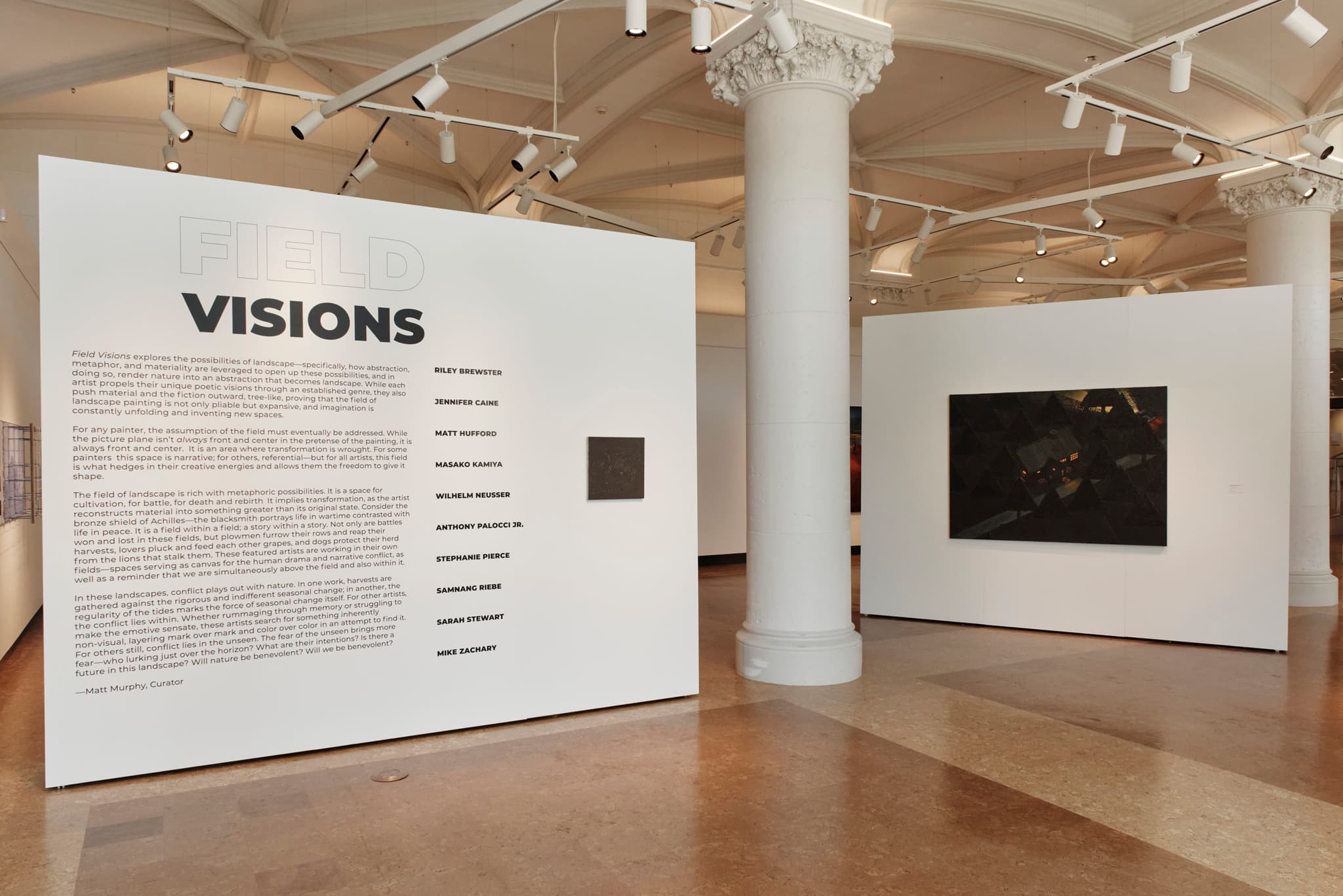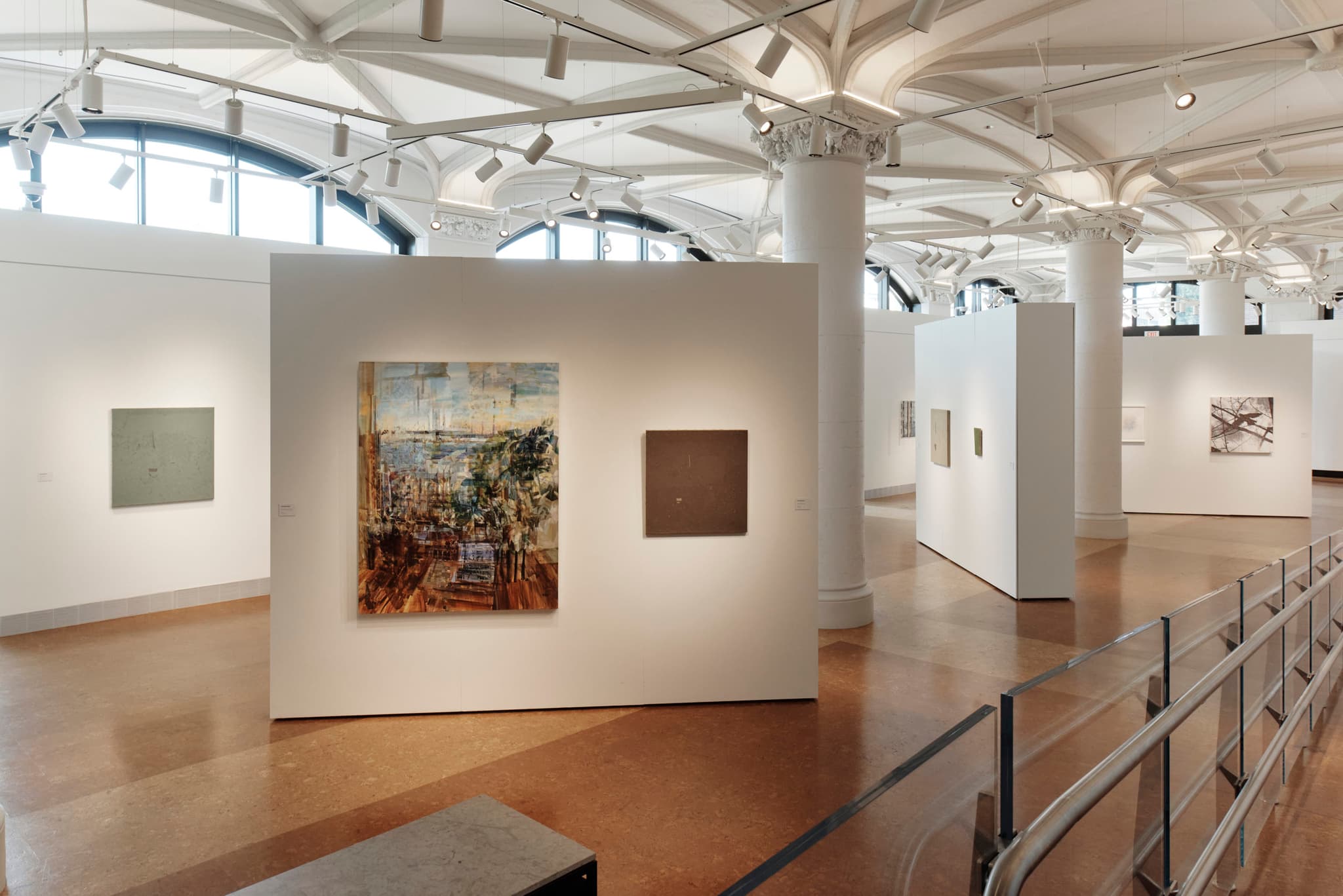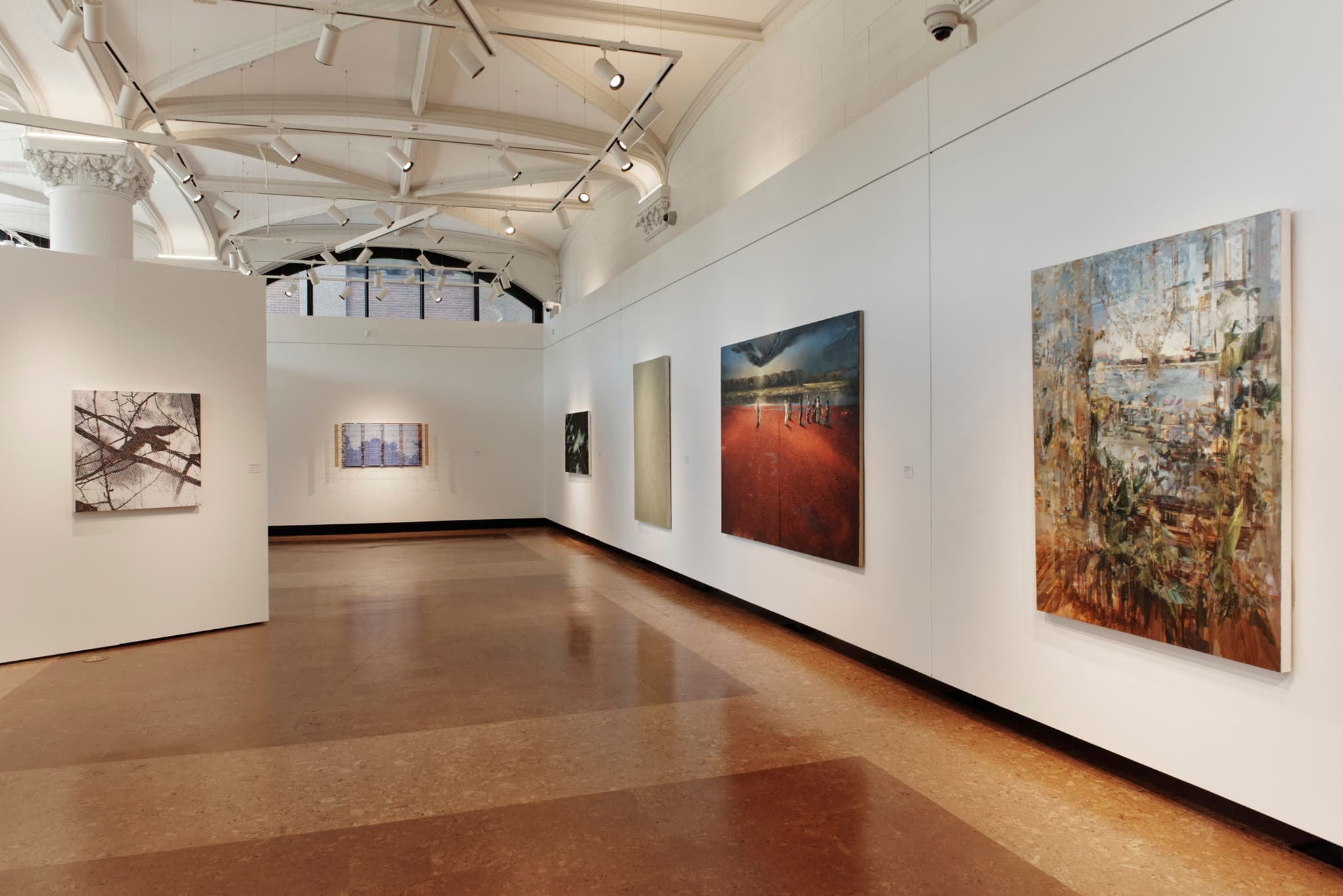Online Only• Jul 05, 2022
Uncharted Territories: A New Look at Landscapes
On view at BU Art Galleries, “Field Visions” explores how ten artists depict and distort the natural world, their immediate surroundings, their minds’ interiors, and the material limits of their practices.
Review by Jessica Shearer
Installation view of “Field Visions,” Boston University Art Galleries, June 14–September 14, 2022. From left to right: Riley Brewster, nostolgie de la boue, 2020; Anthony Palocci Jr., Nightfall, 2020. Photo by Tony Luong, courtesy of Boston University Art Galleries.

Installation view of “Field Visions,” Boston University Art Galleries, June 14–September 14, 2022. From left to right: Riley Brewster, nostolgie de la boue, 2020; Anthony Palocci Jr., Nightfall, 2020. Photo by Tony Luong, courtesy of Boston University Art Galleries.
“Field Visions” is not a typical landscape show, though there are some landscapes in it. Nor is it, as the word “visions” may indicate, particularly esoteric. It is not heralding the revival of a tradition or overtly touting the supremacy of a particular medium, though the nearly thirty pieces on view are all, in one way or another, paintings.
Instead, “Field Visions,” curated by Matt Murphy, is an exploration of any terrain that could arguably fall into the definition of its title’s premise. On view at Boston University’s Stone Gallery until September 14, the exhibition showcases ten artists who depict and distort the natural world, their immediate surroundings, their minds’ interiors, and the material limits of their practices.
The heart of the show is also its art-historical launch pad, Riley Brewster. A New England-based color field painter who has continued engaging in the movement beyond its mid-century heyday, Brewster is also a life-long educator and mentor to many of the artists on view, including Murphy himself. His relatively small, square canvases feel both ancient and intimate, and were the first of the works that Murphy selected for the show.

Installation view of “Field Visions,” Boston University Art Galleries, June 14–September 14, 2022. Photo by Tony Luong, courtesy of Boston University Art Galleries.
To appreciate the textures and intricacies of Brewster’s works, you need to see them in person. From afar they’re serene washes of color in earthy browns, murky greens, and restful taupes. Examined up close, his paintings remind me of fossils pressed into the mud or shapes blackening the backs of your eyelids on a bright day, impressions of light, a smattering of seemingly random marks that together offer a fleeting glimpse into an otherwise arcane private iconography.
Other works evoke more external environments. Michael Zachary and Sarah Stewart, for example, both present expansive interpretations of “scenery” by engaging the line to contort space. Zachary’s meticulous multicolored hatchings act as literal screens, creating distance between the object and its viewer. His birds and waterscapes appear through a humming, buzzy static, as if some internal antenna has snapped. Stewart’s windswept abstractions offer the opposite effect; you seem to fall into them. Note in particular, at 72″ by 48″, subsumes its audience with thousands of razor-thin strokes, creating a sweep of whiplashed green so complete you can practically smell the ozone, sage, and fescue.
Depending on how you situate yourself amidst the gallery’s three floating walls and spacious footprint, you can nestle yourself with single works or take in broad slices of the complete show. Both are rewarding, as Murphy has organized the exhibition to amplify the ways in which each work both relates to and contrasts with the others, rather than hanging by chronology, artist, or strict subject matter. Stand back from Matt Huffford’s Storybook, for example, and you’ll see his emeralds and marigolds picked up in Stephanie Pierce’s Cosmos on the wall just beyond. In both floral scenes, the tonal and thematic harmonies are immediately apparent, while the variations in method and material underscore each painter’s artistic priorities.

Installation view of “Field Visions,” Boston University Art Galleries, June 14–September 14, 2022. From left to right: Matt Hufford, Storybook, 2018, Bramble, 2018, and Filet, 2018; Stephanie Pierce, Cosmos, 2013. Photo by BAR staff.
Hufford’s pieces are tangles of thick, textural gestures with slick taffy edges, exuberant messes of blooms painted on small broken hunks of asphalt (there’s a Joni Mitchell song in there somewhere). While he enacts a physical transformation, Pierce captures a temporal one. Her paintings are time capsules, depictions of her surroundings painted again and again, sometimes over the course of years. In Cosmos, you find her in a brilliant, fragmented garden, seen through a dazzling collection of splintered moments that catch the light and send it ping-ponging all over the canvas.
Nearby, Jennifer Caine and Masako Kamiya highlight Murphy’s curatorial juxtapositions with topographic abstractions. Here, the natural references are more oblique while the subversion of the visual field is more overt, with Caine’s scattered amoebic squiggles like some microscopic plane rendered in hyper-zoom and Kamiya’s stiff pinpricks of paint popping out from paper in a delicate refusal of physics.
Wilhelm Neusser’s single piece, Bog/Promise, taking up much of a far wall, brings us back to more figurative representations with a rupture of ruddy pink. Taken literally, the painting depicts one of Neusser’s favorite themes, a vibrant cranberry bog, but I can’t help but find something Martian in it. Here the waders, lightly sketched in blacks and grays, move against their fruity sludge as if in moon suits, haloed in low-slung light slanting through ominous clouds that descend like some sort of UFO. Its otherworldly aspect is heightened by the proximity of Anthony Palocci Jr.’s Freezing Moon, an eerie, Lynchian midnight scene that too defies simple categorization, oscillating between the titular lunar landscape, a clover-leaf interchange, and creepy crop circles.

Installation view of “Field Visions,” Boston University Art Galleries, June 14–September 14, 2022. Photo by Tony Luong, courtesy of Boston University Art Galleries.
Any landscape, interior or exterior, has the power to both attract and repel, a dichotomy best exemplified by Samnang Riebe’s Por Svay, which—if you’ve followed the most obvious snaking route through the exhibition—is displayed alone on the back wall. Here, you’re offered a simple silhouette, treetops leafing out against a clear sky, a pasture of blue you’re barred from by a grid of metal fencing. Lit from above, the grate—which extends out from the wall by a good half foot—creates a dappled shadow frame. It’s a tantalizing barrier, an encouragement to trespass.
This illustrates a paradox felt throughout the show—a welcome and a rebuff. “Field Visions” adopts a broad view of what a landscape painting can be, and then leans into the personal idiosyncrasies of its artists, an argument that rests less on how we see the world and more on how we experience it. The only downside of the exhibition’s limitless take is that it doesn’t tap easily into the wider discourse regarding the genre; it doesn’t offer an obvious next step. If you’re looking for guideposts leading you directly into the future of the form, you have come to the wrong place.
But then again, who needs a map? When it comes to contemporary landscape painting, perhaps an invitation to explore is all that’s required.
“Field Visions” is on view at the Boston University Art Galleries from June 14 through September 14, 2022.




